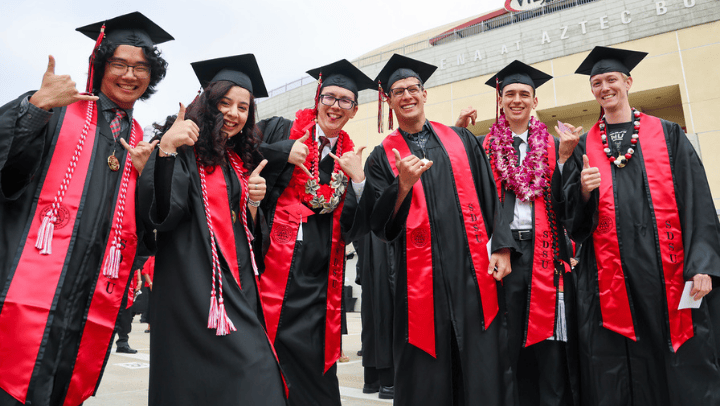The Kennedy Effect
53 years ago, John F. Kennedy came to campus and changed San Diego State history.

Eric Watkins, ’70, had no ticket for the San Diego State Commencement ceremony at which President John F. Kennedy would speak. Back then, on June 6, 1963, the 15-year-old Watkins wasn’t yet an Aztec.
But some instinct—some sense of history—impelled the Crawford High School student to cut classes and make his way to the State campus.
“I had never left school in my life, but that day, I just left. Our president was coming, and not just any president but the one who inspired the nation.”
Watkins slipped though security and found a seat in Aztec Bowl, where carpenters had been sawing and hammering for days to build a dais. Perched high above the dignitaries, the graduates and the college faculty, Watkins had a bird’s eye view of the president speaking to the crowd of 30,000 and receiving the first honorary doctoral degree ever awarded by San Diego State.
“His hair was this incredible color like copper wire,” Watkins recalled. “The way the sun was shining off of his head, it was absolutely radiant. I don’t remember anything he said. I just remember him, bare-headed…young and energetic.
“Then the helicopters lifted, and he was gone. Everything had stopped, like a moment suspended, and it was over. And I remember wondering how on earth did this happen? What brought the president all the way from Washington, D.C. to this campus?”
A bold plan
No one can answer that question more authoritatively than SDSU emeritus professor Henry Janssen. One morning, in the spring of 1963, Janssen heard a news report that Kennedy was to visit the Marine Corps Recruit Depot in San Diego.
He set out from his home in Lemon Grove, biking more vigorously than usual as a bold strategy took shape in his mind. On campus, Janssen eagerly shared the plan with Ned Joy, his office-mate in the Department of Political Science. It was worth a try, they agreed.
Until then, universities within the UC system had been reluctant to partner with San Diego State in doctoral degree programs. San Diego State possessed both the faculty and the labs to support doctoral level research, but state law prohibited the college from awarding doctoral degrees without a research institution partner.
Janssen’s idea had the potential to turn heads among San Diego State’s prospective partners. Why not award an honorary doctorate to the president of the United States?
Associated Students had written to Kennedy and invited him to speak at commencement. Now the plan went into high gear. San Diego State President Malcolm Love called California governor Edmund (Pat) Brown. Days later, both Brown and Kennedy attended the MLB opening day game pitting the Baltimore Orioles against the Washington Senators.
SDSU anthropology chair Seth Mallios continues the story in “Hail Montezuma!” his archaeological history of San Diego State.
“President Kennedy threw out the season’s first pitch; Brown then made a pitch of his own, inviting the president to speak at San Diego State’s commencement ceremony…On May 16, Love received a letter confirming that the U.S. president would indeed attend the event.”
Three weeks to prepare
“It’s Official! Commencement Speaker is President Kennedy,” shouted the Daily Aztec front page headline from May 17, 1963. San Diego State had three weeks to prepare.
While federal security agents surveyed the campus and surrounding area, the university made plans to station 10,000 additional seats on the ground level of Aztec Bowl to accommodate the anticipated crowd. AS officers spent lunch breaks in the bookstore, distributing five precious commencement tickets to each graduating senior.
The San Diego State Symphonic Band rehearsed feverishly for its role—regaling Kennedy and his entourage of White House staff, state and local officials with “Hail to the Chief,” preceded by the customary ruffles (drums) and flourishes (bugles).
College of Arts and Letters Dean Sidney Gulick designed an honorary doctor of law hood, described by the Daily Aztec as having a purple velvet edge and scarlet silk lining with a 5-inch-wide black V stripe in the center.
Meanwhile, the city of San Diego also prepared to welcome the head of state and the hundreds of national print, television and radio reporters who would arrive to cover his visit.
Officials mapped out a parade route from Lindbergh Field, east along El Cajon Boulevard. Marines would be stationed every 5-to-6-feet to keep the crowds at bay.
Graciousness and humility
The morning of June 6, 1963 was warm and overcast. San Diego’s infamous June gloom did not disappoint.
Kennedy was scheduled to arrive just before noon, but preparations began long before then. Angel Flight—an honorary auxiliary of the Air Force ROTC and the official campus hostesses—met to review its charge of helping the president don his ceremonial robe and hood.
Associated Students representatives also played an important role in the ceremonies, leading the procession of dignitaries into the stadium. As a bonus, the four class officers had front row seats.
“We were told not to bring cameras and photograph the president, but everyone did,” said Diane Dawson, ’63, former AS treasurer.
Of all that Dawson recollects about the day, the most vivid memory is Kennedy’s inimitable style.
“There was a real graciousness about his remarks, as if we were his personal friends. And there was a degree of humility too, like we had done him a favor by asking him to speak. My father was on the faculty at Stanford and he was truly impressed that the president had come to San Diego State."
“We are the privileged”
Clearly, Kennedy had come with a purpose. His address, trumpeted to the press as a major policy speech, was an impassioned appeal for national support of equal access to higher education.
He began by congratulating California’s commitment to education. “I do not believe that any state in the union has given more attention in recent years to educating its citizens to the highest level…”
Continuing, the president observed that not all states were equally enlightened. “In some states almost 40 percent of the non-white population has completed less than five years of school…What kind of judgment, what kind of response can we expect of a citizen who has been to school less than five years?”
Kennedy argued for education as a national priority, “at the top of the responsibilities of any government [because] it is essential to our survival as a nation…to the maintenance of freedom at a time when freedom is under attack.”
And he ended his remarks with a call to action. “We are the privileged, and it should be the ambition of every citizen to express and expand that privilege so that all of our countrymen and women share it.”
Yearbook dedication
Perhaps because Kennedy gave the San Diego State community a new self-respect, his loss six months later grieved many Aztecs deeply.
Sue Hotz, ’66, remembers the hushed, somber atmosphere on campus that November day when Kennedy was assassinated. An editor for Del Sudoeste, she dedicated the yearbook’s 1964 senior section to the slain president.
It said: “Every emotion has been touched. Every word has been spoken. He lies in history; Now is the time for reflection,” the inscription reads.
A half-century later, this story does have a happy ending. Just four years after Kennedy came to San Diego State, the college awarded its first non-ceremonial doctorate—in partnership with UC San Diego. The degree in chemistry went to Robert Metzger, who subsequently became a professor of chemistry at SDSU.
Today, San Diego State College is San Diego State University with 21 doctoral degree programs, a dynamic research agenda and a diverse student population. President Kennedy would have been pleased.
Robert Ray, director of Special Collections, provided historical images and invaluable editorial assistance for this story.



